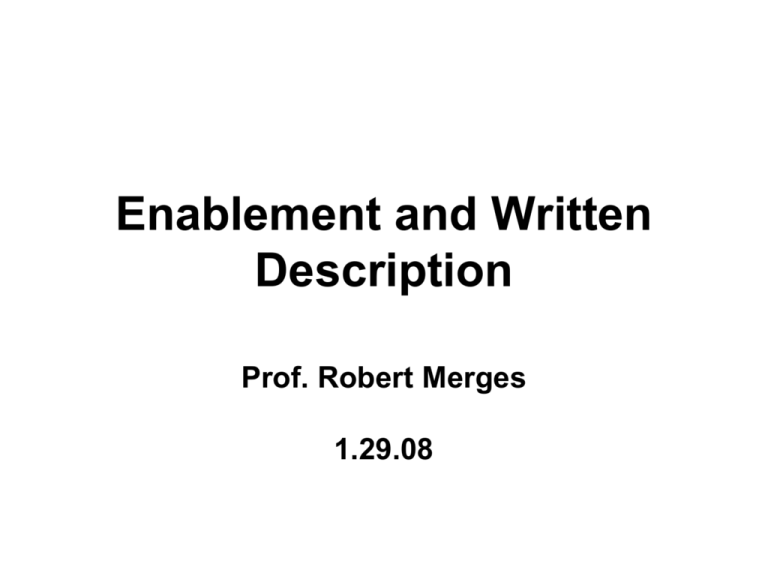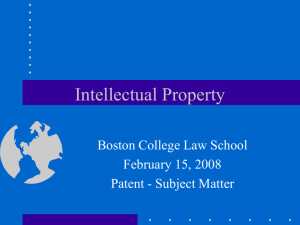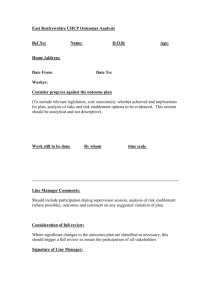Enablement and Written Description
advertisement

Enablement and Written Description Prof. Robert Merges 1.29.08 Disclosure/Enablement, § 112 ¶ 1 Written Description of Claimed Invention ¶ 1 Enablement of one skilled in the art without undue experimentation of: • how to make • how to use ¶ 1 Best Mode contemplated by inventor ¶ 2,6 Claims - definiteness Disclosure/Enablement, § 112 U.S.C. § 112: ¶ 1 The specification shall contain a written description of the invention, and of the manner and process of making and using it, in such full, clear, concise, and exact terms as to enable any person skilled in the art to which it pertains, or with which it is most nearly connected, to make and use the same, and shall set forth the best mode contemplated by the inventor of carrying out his invention. U.S.C. § 112: ¶ 2 The specification shall conclude with one or more claims particularly pointing out and distinctly claiming the subject matter which the applicant regards as his invention. U.S.C. § 112: ¶ 3 A claim may be written in independent or, if the nature of the case admits, in dependent or multiple dependent form. U.S.C. § 112: ¶ 4 Subject to the following paragraph, a claim in dependent form shall contain a reference to a claim previously set forth and then specify a further limitation of the subject matter claimed. A claim in dependent form shall be construed to incorporate by reference all the limitations of the claim to which it refers. U.S.C. § 112: ¶ 5 A claim in multiple dependent form shall contain a reference, in the alternative only, to more than one claim previously set forth and then specify a further limitation of the subject matter claimed. A multiple dependent claim shall not serve as a basis for any other multiple dependent claim. A multiple claim shall be construed to incorporate by reference all the limitations of the particular claim in relation to which it is being considered. U.S.C. § 112: ¶ 6 An element in a claim for a combination may be expressed as a means or step for performing a specified function without the recital of structure, material, or acts in support thereof, and such claim shall be construed to cover the corresponding structure, material, or acts described in the specification and equivalents thereof. Updating Incandescent Lamp • Federal Circuit: – Enablement is an issue of fact • Standard has not changed Patents are required to "teach those skilled in the art how to make and use the full scope of the claimed invention without 'undue experimentation.' " Genentech Inc. v. Novo Nordisk A/S, 108 F.3d 1361, 1365 (Fed.Cir.1997). Contrasting Recent Cases • Koito Manufacturing Co., Ltd. v. Turn Key Tech, 2004 WL 1872719 C.A.Fed. (Cal.), Aug. 23, 2004. – Enablement satisfied • AK Steel Corp. v. Sollac and Ugine, 344 F.3d 1234, C.A.Fed. (Ohio), 2003. – Invalid, lack of enablement The technology • Bristol-Myers Squibb (BMS) was the first company to develop and patent a liquid pharmaceutical composition of megestrol acetate. BMS' U.S. Patent No. 5,338,732 (the Atzinger patent) teaches that stable suspensions of megestrol acetate can be created but that the type and concentration of the surfactant in solution is critical to creating a stable flocculated suspension. Tech (cont’d) • Megestrol acetate • A synthetic progestational hormone C24H32O4 Surfactants Surfactants (“surface active agents”) are artificially manufactured molecules whose jobs are to suspend substances in water. They can do this because of their unique molecular structure. One end of the surfactant molecule is hydrophilic -- it likes water. The other end is lipophilic -- it likes fats. The lipophilic end is also referred to as being hydrophobi.c Development of the invention When [patentee] Par formulated a generic version of BMS's patented product, it sought to design around the Atzinger patent claims by utilizing other surfactants and wetting agents. In developing its own product, Par discovered that flocculated suspensions of megestrol acetate could be formed using a much wider range of ingredients and concentrations than taught in the Atzinger patent. The claims in Atzinger, prior art 1. An oral pharmaceutical composition comprising [a] micronized megestrol acetate at a concentration of 15 to 150 mg/mL [b] in combination with polysorbate [surfactant] at a concentration of 0.005% to 0.015% weight/volume and [c] polyethylene glycol at a concentration of greater than 5% weight/volume [d] which composition forms a stable flocculated suspension in water. Claimed invention: Patentee’s ‘318 patent 1. A method of treating a neoplastic condition comprising administering to a subject suffering from said condition an oral pharmaceutical composition in the form of a stable flocculated suspension in water capable of being redispersed after being allowed to settle at 40.degree. C. and 75% relative humidity for a period of three months, Claimed invention: Patentee’s ‘318 patent said composition comprising: (a) micronized megestrol acetate; (b) about 10 to 40% by weight of at least one compound selected from the group consisting of polyethylene glycol, propylene glycol, glycerol, and sorbitol; and (c) about 0.0001 to 0.03% by weight of a surfactant, wherein polysorbate and polyethylene glycol are not simultaneously present in said composition. The litigation Par brought the present suit in 2003, asserting that Roxane infringes certain claims in the ′318 and ′320 patents. Roxane denies infringement and asserts that the claims of the ′318 and ′320 patents are invalid and unenforceable. Roxane moved for summary judgment of invalidity, arguing, inter alia, that the asserted claims in the ′ 318 and ′320 patents are invalid for lack of enablement. The opinion: Pharm. Res. v. Roxane • “In this case, Par sought extremely broad claims in a field of art that it acknowledged was highly unpredictable, therefore, Par has set a high burden that its patent disclosure must meet to satisfy the requisite quid pro quo of patent enablement.” -- 2007 WL 3151692, at 2. Pharm. Res. v. Roxane “The language of the claims and the specification both suggest that the claims encompass hundreds of possible surfactants.” -- 2007 WL 3151692, at 4 Inoperative species • Par now suggests that an ordinarily skilled artisan would know that surfactant concentrations over 0.030% weight-pervolume would not work, it follows that a large part of the asserted claims' scope is directed toward inoperative embodiments. The number of inoperative combinations is significant when assessing the experimentation that an ordinarily skilled artisan would need to practice the claimed invention. Atlas Powder Co. v. E.I. Du Pont De Nemours & Co., 750 F.2d 1569, 1576 (Fed.Cir.1984). “Par's specification discloses only three working examples, utilizing only one new surfactant. Given the highly unpredictable nature of the invention and the extremely broad scope of the claims, these three working examples do not provide an enabling disclosure commensurate with the entire scope of the claims.” – p. 4. Contrasting case • Koito Manufacturing Co., Ltd. v. Turn Key Tech, 2004 WL 1872719 C.A.Fed. (Cal.), Aug. 23, 2004. – Enablement satisfied • United States Patent 5,045,268 Sorensen September 3, 1991 Crosslamination injection molding • Abstract • A plastic product having a cross-laminated section including a first plastic layer and a second plastic layer is injection molded in a mold system that includes a first mold cavity with a first-layer-definingmold-cavity-section and a second mold cavity with a second-layerdefining-mold-cavity-section that has a second-cavity-section-wall. The product is molded by injecting a quantity of first plastic into the first mold cavity so that first plastic flows from a flow channel into the first-layer-defining-mold-cavity-section in a first predetermined general direction that is different than the direction of the flow channel; solidifying at least partly the flowed first plastic in the firstlayer-defining-mold-cavity-section to thereby form said first plastic layer having a first-direction-flow-record; adjusting the mold system to provide the second mold cavity, with the second-cavity-sectionwall including the first plastic layer; injecting a quantity of second plastic into the second mold cavity “Koito also argues on appeal that certain details used by Turn-Key, such as injection parameters and gate size, were necessary for one of skill in the art to practice the claimed invention without undue experimentation. We again find that Koito failed to put forth clear and convincing evidence at trial that knowledge of such production details was necessary to practice the claimed invention without undue experimentation.” “In contrast to the absence of evidence by Koito, Turn-Key presented evidence by the inventor of the '268 patent that these details were omitted from the patent because they are "standard in the industry." This Court has repeatedly explained that a patent applicant does not need to include in the specification that which is already known to and available to one of ordinary skill in the art.” -- 2004 WL 1872719, at 10. “We thus have noted that "[n]ot every last detail is to be described, else patent specifications would turn into production specifications, which they were never intended to be ." In re Gay, 50 C.C.P.A. 725, 309 F.2d 769, 774 (CCPA 1962). Unless there is evidence to the contrary, therefore, the lack of certain production details does not indicate failure of enablement.” – Id. The Written Description Requirement Scope of enablement vs. scope of that which you have “described” Gentry Gallery, Inc. v. Berkline Corp., 134 F.3d 1473 (Fed. Cir. 1998). Original Claim Language: Prosecution History: Amended Claim Language: Gentry was granted a patent for a sectional sofa comprised of a pair of reclining seats that faced the same direction. Claim 1, the broadest claim, identifies a “fixed console” between the pair of seats. Claims 9, 10, 12-15, and 19-21 are directed to a sectional sofa in which the control means are specifically located on the console. The term “console” does not cover a sofa section having a seat back that folds down to serve as a table top. (This was to distinguish Gentry’s sofa from prior art.) The Federal Circuit limits the scope of the claim to cover sofas in which the recliner control is located on the console and invalidates 12 claims in the patent under § 112. The court affirmed that Berkline had not infringed on Gentry’s patent by constructing reclining chairs separated by a center seat whose back cushion pivoted to form a table. Gentry Gallery, cont’d Canon 1: Claims should be interpreted such that the preferred embodiment falls within their scope. Gentry Gallery, Inc. v. Berkline Corp., 134 F.3d 1473 (Fed. Cir. 1998). Original Claim Language: Prosecution History: Amended Claim Language: Gentry was granted a patent for a sectional sofa comprised of a pair of reclining seats that faced the same direction. Claim 1, the broadest claim, identifies a “fixed console” between the pair of seats. Claims 9, 10, 12-15, and 19-21 are directed to a sectional sofa in which the control means are specifically located on the console. The term “console” does not cover a sofa section having a seat back that folds down to serve as a table top. (This was to distinguish Gentry’s sofa from prior art.) The Federal Circuit limits the scope of the claim to cover sofas in which the recliner control is located on the console and invalidates 12 claims in the patent under § 112. The court affirmed that Berkline had not infringed on Gentry’s patent by constructing reclining chairs separated by a center seat whose back cushion pivoted to form a table. In re Curtis, 69 USPQ2d 1274 (CA FC 2004) 69 USPQ2D 1274 In re Curtis U.S. Court of Appeals Federal Circuit No. 03-1215 Decided January 6, 2004 In re Curtis, cont’d • The Board determined that Curtis could not traverse the examiner’s rejections by claiming the benefit of an earlier patent application because the disclosure therein failed to adequately describe the subject matter encompassed by the rejected claims under 35 U.S.C. §112, ¶ 1. Because the Board’s decision is supported by substantial evidence and otherwise is in accordance with law, we affirm.
![Introduction [max 1 pg]](http://s3.studylib.net/store/data/007168054_1-d63441680c3a2b0b41ae7f89ed2aefb8-300x300.png)

